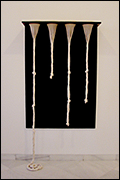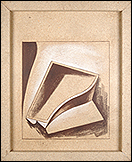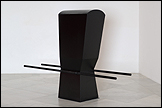PEPE
ESPALIÚ. 1987 - 1992
DEPOSIT AND WORKS AT CAAC COLLECTION
Date: April - June 2012
Places: Pabellón Real y Capilla de Afuera
The work of Pepe Espaliu (Cordoba, 1955-1993) shown here belongs to
the collection
of the Centro Andaluz de Arte Contemporaneo (CAAC). The highlight
is the incorporation of the piece from 1989 Four Provisional Suicides,
a recent donation by a Seville art collector. Chronologically, this
work integrates the existing collection of the museum. The sculpture,
which was shown that year in an individual exhibition at New York's
Brooke Alexander gallery, now returns to Andalusia and continues to
evoke cold and extreme sensations without naming them.
Espaliu's training in Barcelona and Paris, as well as his life-changing periods in Amsterdam and New York, provided him with a rich artistic, literary and philosophical background, which led to a short but intense artistic career. He was part of the Seville group which founded Figura art magazine in the '80s and opened the now closed art gallery "La Maquina Espanola", opened in Seville around that time and which became an important point of reference for the opening to the international art trend. This period constitutes his pictorial works, which he would abandon shortly after to devote himself to drawing and sculpture.
Over the course of his career, Espaliu tackled complex subjects such as identity, fragility, pain and pleasure or death. There is also a biographical element which becomes more apparent after the artist contracted AIDS in the early '90s. The decision to integrate this life experience into his work encouraged him to produce some of his most relevant works. Among these, the series of sculptures titled "Carrying", which features two figures and a video -showing the performance given in San Sebastian in 1992- where an ill and barefoot Pepe Espaliu was carried along the streets by a human chain. This was a way of stirring up emotions, raising awareness and breaking social taboos. Just like art critic Juan Vicente Aliaga said: "in the eyes of Espaliu, one must relate to the disease right from the disease itself, seen as a symbolic form of love."


